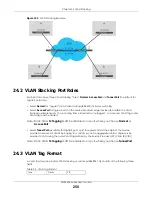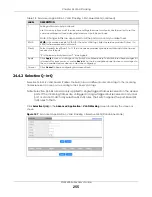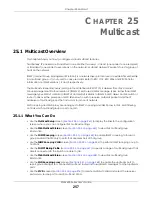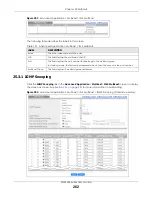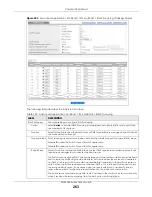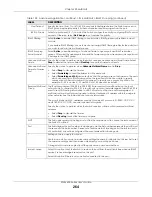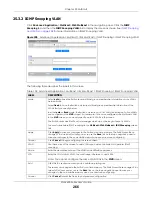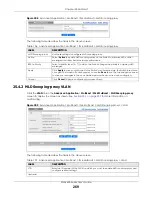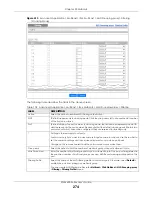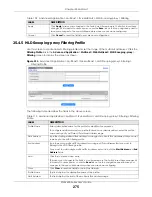
Chapter 25 Multicast
XGS4600 Series User’s Guide
260
MVR Overview
Multicast VLAN Registration (MVR) is designed for applications (such as Media-on-Demand (MoD)) that
use multicast traffic across an Ethernet ring-based service provider network.
MVR allows one single multicast VLAN to be shared among different subscriber VLANs on the network.
While isolated in different subscriber VLANs, connected devices can subscribe to and unsubscribe from
the multicast stream in the multicast VLAN. This improves bandwidth utilization with reduced multicast
traffic in the subscriber VLANs and simplifies multicast group management.
MVR only responds to IGMP join and leave control messages from multicast groups that are configured
under MVR. Join and leave reports from other multicast groups are managed by IGMP snooping.
The following figure shows a network example. The subscriber VLAN (
1
,
2
and
3
) information is hidden
from the streaming media server,
S
. In addition, the multicast VLAN information is only visible to the
Switch and
S
.
Figure 199
MVR Network Example
Types of MVR Ports
In MVR, a source port is a port on the Switch that can send and receive multicast traffic in a multicast
VLAN while a receiver port can only receive multicast traffic. Once configured, the Switch maintains a
forwarding table that matches the multicast stream to the associated multicast group.
MVR Modes
You can set your Switch to operate in either dynamic or compatible mode.
In dynamic mode, the Switch sends IGMP leave and join reports to the other multicast devices (such as
multicast routers or servers) in the multicast VLAN. This allows the multicast devices to update the
multicast forwarding table to forward or not forward multicast traffic to the receiver ports.
In compatible mode, the Switch does not send any IGMP reports. In this case, you must manually
configure the forwarding settings on the multicast devices in the multicast VLAN.
How MVR Works
The following figure shows a multicast television example where a subscriber device (such as a
computer) in VLAN 1 receives multicast traffic from the streaming media server,
S
, through the Switch.
Multiple subscriber devices can connect through a port configured as the receiver on the Switch.
Содержание XGS4600 Series
Страница 24: ...24 PART I User s Guide ...
Страница 44: ...44 PART II Technical Reference ...
Страница 180: ...Chapter 13 Spanning Tree Protocol XGS4600 Series User s Guide 180 Figure 145 MSTP and Legacy RSTP Network Example ...
Страница 189: ...Chapter 16 Mirroring XGS4600 Series User s Guide 189 Figure 150 Advanced Application Mirroring Standalone Mode ...
Страница 244: ...Chapter 22 Policy Rule XGS4600 Series User s Guide 244 Figure 189 Policy Example EXAMPLE ...
Страница 277: ...Chapter 25 Multicast XGS4600 Series User s Guide 277 Figure 215 Advanced Application Multicast MVR Standalone Mode ...
Страница 559: ...Chapter 59 Access Control XGS4600 Series User s Guide 559 Figure 460 Example Lock Denoting a Secure Connection EXAMPLE ...
Страница 586: ...Chapter 69 Configure Clone XGS4600 Series User s Guide 586 Figure 479 Management Configure Clone Standalone Mode ...
Страница 587: ...Chapter 69 Configure Clone XGS4600 Series User s Guide 587 Figure 480 Management Configure Clone Stacking Mode ...
Страница 594: ...Chapter 71 Port Status XGS4600 Series User s Guide 594 Figure 485 Management Port Status Port Details Standalone Mode ...
Страница 604: ...604 PART III Troubleshooting and Appendices ...





